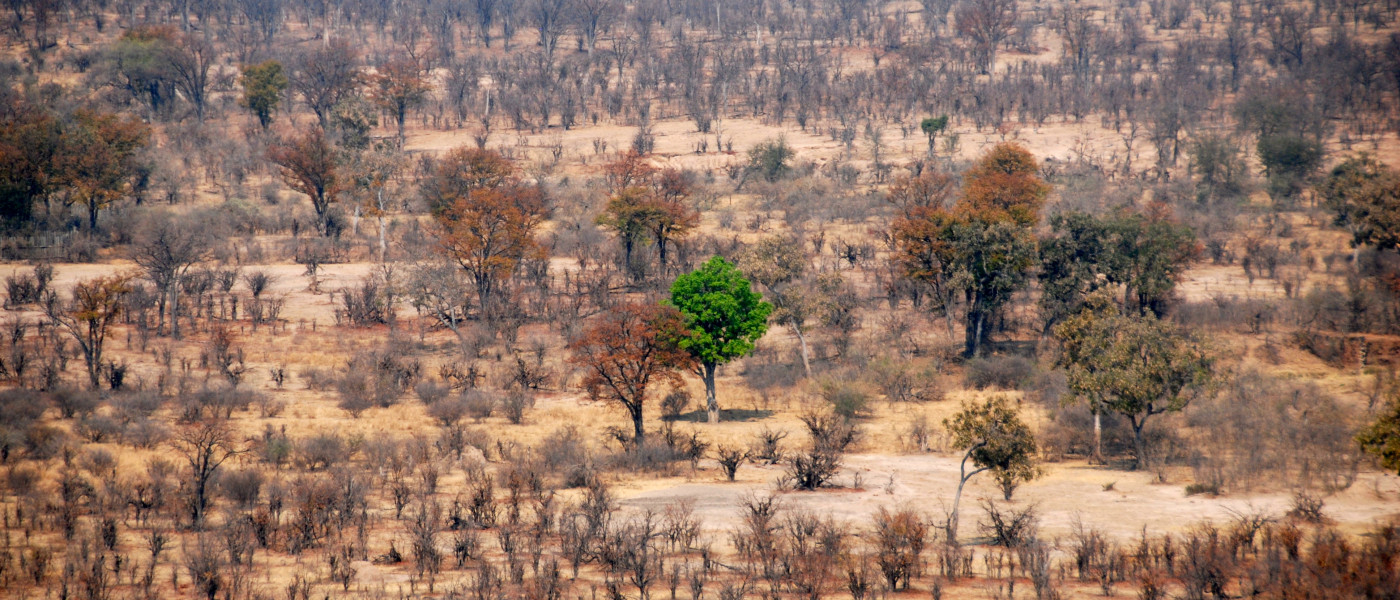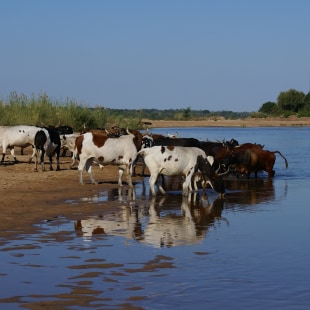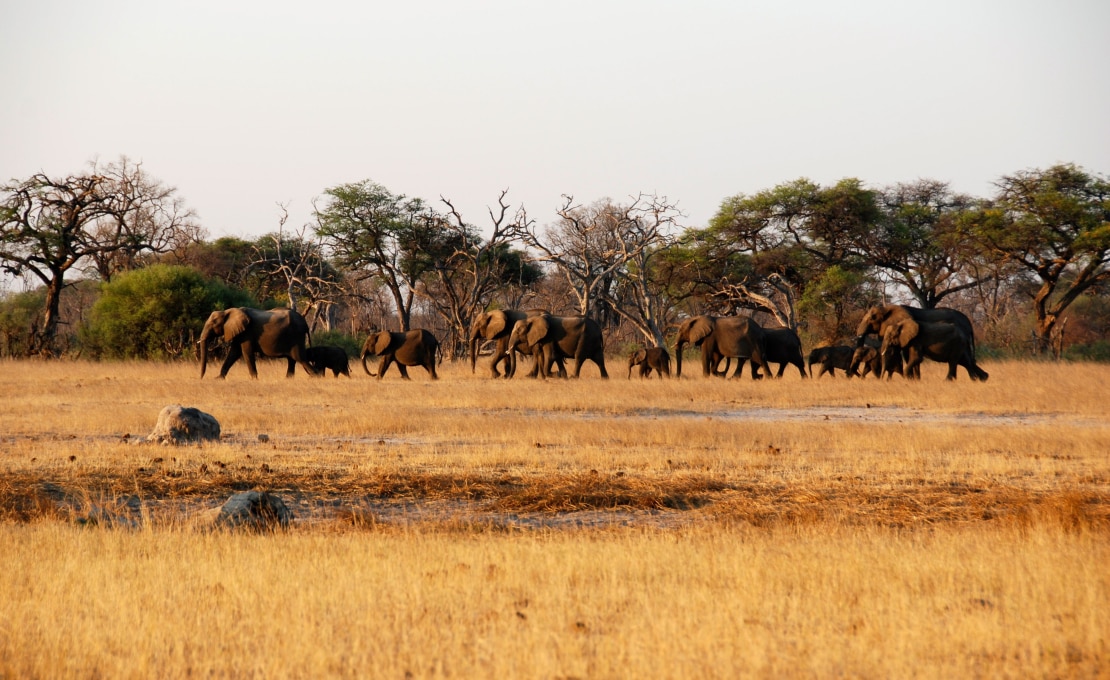The « HUM-ANI » project
Supported by the BNP Paribas Foundation through its Climate & Biodiversity Initiative, the “HUM-ANI” project particularly addresses the Sustainable Development Goals (SDG) 3 “Good health and Well-being” and 15 “Life on Land”.
Led by Eve Miguel, researcher in Ecology and Epidemiology at the French National Research Institute for Sustainable Development (IRD), this project arises in the context of climate change and biodiversity erosion. It focuses on transmission of pathogens between wild animal, domestic animal, and human species (“multi-hosts transmission”), at Human/Nature interfaces in Southern Africa. Does biodiversity protect from the zoonotic risk, i.e. the risk of disease transmission from animals to humans, but also from diseases of domestic and wild animals?
« Little is still known about epidemiology in wildlife in general. This is why we want to test empirically our assumptions by tracking numerous species in time and space, as well as to find solutions for a sustainable coexistence of people and nature. »
Nowhere is climate change having a greater impact than on the African continent
Temperatures on the African continent are rising faster than the global rate: in Southern Africa, the dry season is lasting longer and longer and the rainy season is often torrential. This destabilisation of climate, the importance of agriculture and even habitat fragmentation greatly affect biodiversity.The population abundance of large mammals in Africa has declined by 59% from 1970 to 2005[1].
Moreover, according to IPBES*, it could result in significant losses of African plant species and of over 50 % bird and mammal species by 2100 [2]. This is why, since the late seventies, we have seen a 500% increase in land designated as protected areas (PAs) for nature conservation. [3]
*IPBES : Intergovernmental Science-Policy Platform on Biodiversity and Ecosystem Services
Climate risks modify behaviours too
All these impacts also affect the behaviour of wild and domestic animals as well as humans: human and domestic animals populations have more than doubled near these Protected Areas (PAs). Where to turn when water and pastureland are in short supply? Subsistence farming in Zimbabwe: the cowman guides the herd to the Limpopo River (to the north of the Kruger National Park at the border of South Africa) so it can drink.
Climate change and biodiversity erosion: the causes of infectious diseases’ emergence and propagation
The risks for wildlife, livestock and human in term of infectious diseases are neither well understood nor predicted in the scientific literature, especially in this context of species extinctions, climate change and resources limitation. Addressing the consequences for infectious diseases’ dynamics is thus crucial.
Multi-species transmission is a key process in the emergence, spread and distribution of many infectious diseases (here, becoming endemic) of humans and animals (domestic or wild). The predicted increase in aridity in Southern Africa will likely decrease primary production and make resource availability in space and time (surface water and forage) more uncertain. The increasing spatial overlap between pristine and agricultural environments, as well as the collapse of biodiversity, are likely to redistribute inter-specific contact patterns and affect species jump processes.
Would these new interactions facilitate the transmission of pathogens between species?
An innovative and timely research project
How are loss of biodiversity, increased temperatures and rainfall disturbance (i.e. cycle of droughts and torrential rainfall) likely to modify the contact networks between wild animals, domestic animals & humans, and thus to increase infectious diseases risks for wildlife, livestock and humans?
The originality of the “HUM-ANI” project lies in the equal importance given to its three pillars:
- Ecology: to track animal movements and species diversity in different climatic conditions by fitting over 70 GPS collars and settle 30 camera traps to observe the different wild and domestic animal species.
- Epidemiology: to detect the presence of infectious pathogens in the target species and analyse the transmission dynamics, based on non-invasive sampling from saliva and faeces left in the environment.
- Social sciences: to better understand how humans use the resources in protected areas (e.g. pasturelands, water sources, bush meat) in times of climatic and economic crises, through social surveys and workshops.
“HUM-ANI”: a citizen science project
The “HUM-ANI” project will establish the first Eco-health mobile lab, a type of Human/Nature think tank that will be specially designed to do « traditional field research » as well as citizen science and scientific outreach towards populations.
Indeed, equipped with a large screen to project results and to program cultural events, this small bus will allow carrying out the integrated research on the link between biodiversity, health and climate change, along with favour communication between scientists, wildlife managers and other local stakeholders.The fieldwork will provide ground-breaking scientific data to parameterize epidemiological models and understand pathogen circulation in multi-host systems under different conditions.
In the current context of Covid-19 pandemic, the issue of the links between climate change, biodiversity erosion and pandemic is more than ever at the top of the environmental and health concerns. In fine, these research will help decision makers identify the best management strategies to apply for the sustainable development of the socio-ecosystems at the Human/Nature interfaces.
HUM-ANI video Project: role in the emergence of infectious diseases
"HUM-ANI” embarks real innovation that will deliver strong impact and great outreach, as the health consequences of climate change and biodiversity collapse are a major stake with big echo"
To go further
- Eco-health: an emerging science enabling efficient fight against epidemics – article and podcast about Eve Miguel’s works
- Better understand the spread of viruses between species (Mieux comprendre la diffusion des virus entre les espèces) – article in French by Eve Miguel, for The Conversation France
- Too little is known about wildlife epidemiology (On sait trop peu de choses sur l’épidémiologie de la faune sauvage) – interview in French of Eve Miguel, by Yseult Berger for Le Blob
- Facing pandemics, ecology sciences are more important than ever (Face aux pandémies, les sciences de l’écologie sont plus que jamais nécessaires) – article in French co-written by Eve Miguel
[1] . Craigie, I.D., et al., Large mammal population declines in Africa's protected areas. Biological Conservation, 2010).
[2]. The IPBES regional assessment report on biodiversity and ecosystem services for Africa, E.D. Archer, L., Mulongoy, K. J., Maoela, M. A., and Walters, M. (eds.). Secretariat of the Intergovernmental Science-Policy Platform on Biodiversity and Ecosystem Services, Bonn, Germany., Editor. 2018. p. 492.
[3] . George Wittemyer, et al., Accelerated Human Population Growth at Protected Area Edges. Science, 2008.



